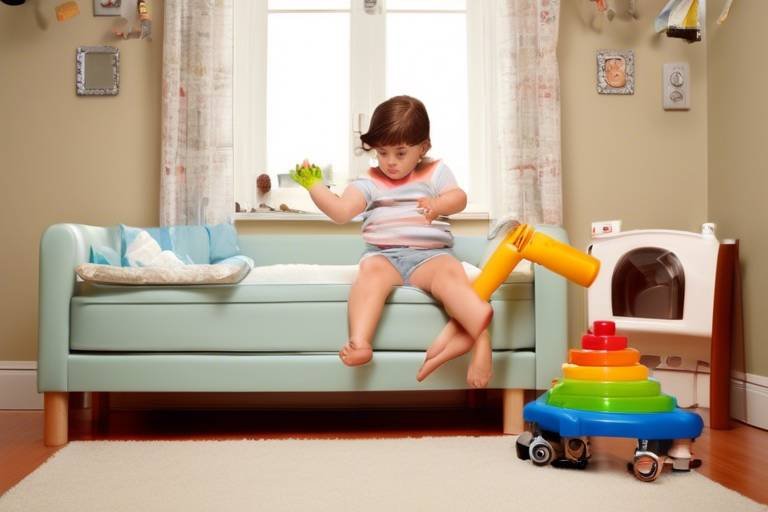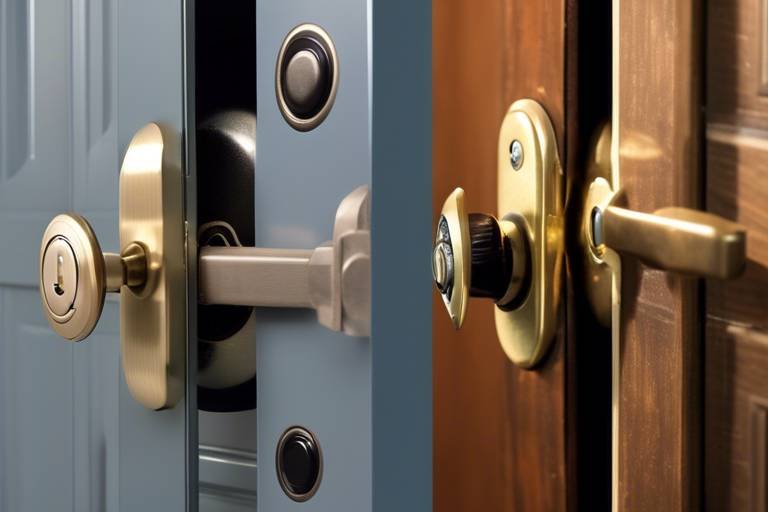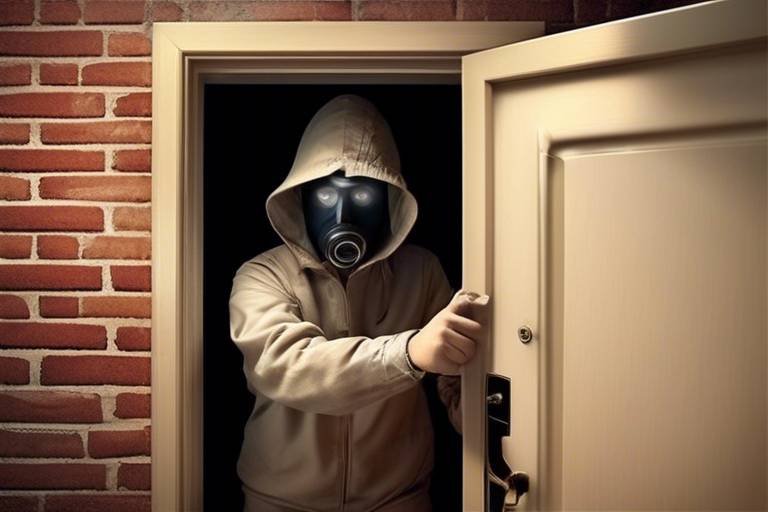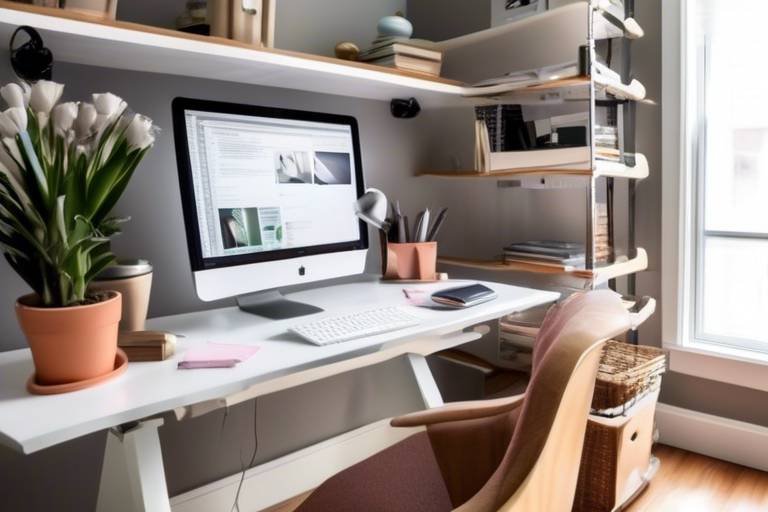Must-Have Home Safety Products for Kids
As parents, our primary goal is to create a safe haven for our little ones. The world is full of wonders and dangers, and while we want our kids to explore, we also need to ensure they remain protected from potential hazards lurking around the home. From the moment they start crawling to when they take their first steps, children are naturally curious, and that curiosity can lead them into tricky situations. That's why having the right home safety products is not just a luxury; it's a necessity. In this article, we’ll dive into the essential safety products designed specifically for children, helping you transform your home into a fortress of safety. We’ll cover everything from childproofing essentials to specific items like safety gates and outlet covers, ensuring you have all the tools you need to keep your little explorers safe.
Childproofing is crucial for creating a safe environment. Think of it as setting up a protective bubble around your child, where they can roam freely without the constant worry of injury. This section covers the fundamental products every home should have to minimize risks and hazards for young children. The truth is, childproofing isn’t just about buying products; it's about being proactive and anticipating the potential dangers that come with having a curious toddler in the house. This means securing furniture, covering sharp edges, and ensuring that hazardous materials are out of reach. By taking these steps, you’re not only protecting your child but also giving yourself peace of mind.
Safety gates are vital for restricting access to hazardous areas. Whether it’s a staircase that poses a risk of falls or a room filled with breakable items, safety gates act as a barrier, allowing you to control where your child can go. It’s like having a friendly guard that keeps your little one safe from potentially dangerous zones in your home. Here, we will discuss the different types of safety gates and their appropriate applications in the home. Understanding the various options available will help you make an informed choice that best suits your living space and lifestyle.
Various safety gates are available, including pressure-mounted and hardware-mounted options. Understanding their differences can help parents choose the best fit for their home. Pressure-mounted gates are typically easier to install and can be moved around as needed, making them perfect for temporary barriers. On the other hand, hardware-mounted gates are bolted to the wall, providing a more secure option for high-traffic areas. This is especially important in homes with stairs, where a sturdy gate can prevent serious accidents.
Pressure-mounted gates are easy to install and ideal for temporary use. They provide a quick solution for blocking off areas without damaging walls. Imagine being able to set up a barrier in seconds—no tools required! These gates are fantastic for keeping little ones out of kitchens or living rooms during playtime, allowing parents to relax while their children enjoy their space safely.
Hardware-mounted gates offer a more secure option for high-traffic areas. They are bolted to the wall, making them suitable for stairs and other potentially dangerous locations. When it comes to safety, these gates are like the heavy-duty locks on your front door—they're designed to withstand the test of time and keep your little ones secure. While installation may take a bit longer, the peace of mind they provide is worth every second spent.
Proper installation of safety gates is essential for effectiveness. This section will provide practical tips to ensure gates are securely fitted and functioning well. Always follow the manufacturer's instructions closely and check the gate regularly for any signs of wear and tear. It’s also wise to ensure that the gate is installed at the correct height and that it swings open away from the stairs, if applicable. Remember, a well-installed gate is your first line of defense against unexpected tumbles.
Protecting children from electrical hazards is paramount. Outlet covers and safety plugs are simple yet effective tools that can prevent accidental shocks. Think of them as the invisible shield that guards your child from the dangers of electricity. This section discusses the importance of these products in preventing accidents and ensuring that your home remains a safe place for your little ones to explore.
There are various outlet cover designs, including sliding and locking types. Each offers different levels of protection, catering to diverse household needs. Sliding covers are easy for adults to use but can be tricky for little fingers, while locking covers provide an extra layer of security. Choosing the right type of outlet cover can be a game-changer in your childproofing efforts.
Regular checks and proper installation of outlet covers are crucial. This section highlights best practices for ensuring ongoing safety in your home. Always ensure that covers fit snugly and check them periodically for any wear. It’s also a good idea to educate older siblings about the importance of keeping outlets covered, turning safety into a family affair.
Sharp corners and edges pose risks for young children. Think of how often kids run or tumble; those sharp edges can turn an innocent fall into a trip to the ER. This section covers the various types of corner and edge protectors available to safeguard little ones from injuries. By softening those hard edges, you’re not just preventing injuries; you’re creating a more inviting and safe environment for play.
Corner protectors come in different materials, such as foam and silicone. This section will explore the pros and cons of each to help parents make informed choices. Foam protectors are lightweight and easy to install, while silicone options are more durable and can withstand the wear and tear of busy households. Choosing the right material can enhance both safety and aesthetics in your home.
Correct installation of corner and edge protectors ensures maximum safety. Here, we will provide tips for effective application in various home settings. Make sure to clean the surface before applying, and press firmly for a secure fit. Regularly check these protectors for any signs of loosening, as a proactive approach can prevent accidents before they happen.
1. What age should I start childproofing my home?
It’s best to start childproofing as soon as your baby begins to crawl. This proactive approach helps prevent accidents before they occur.
2. Are safety gates necessary for all homes?
While not every home requires safety gates, they are highly recommended for homes with stairs or areas that pose a risk of injury.
3. How often should I check my outlet covers?
Regular checks are vital; inspect your outlet covers at least once a month to ensure they are secure and functioning correctly.
4. Can I use corner protectors on furniture?
Absolutely! Corner protectors are designed for furniture edges, making them perfect for coffee tables, cabinets, and other sharp-edged furniture.

Childproofing Essentials
When it comes to keeping our little ones safe at home, childproofing is not just a good idea; it's a necessity. Children are naturally curious, and their explorative nature can lead them into dangerous situations if we’re not careful. So, what exactly do we need to make our homes safer for kids? Let’s dive into some of the fundamental products that every parent should consider to minimize risks and hazards.
First off, you can't go wrong with baby gates. These handy devices are designed to block off areas that might be unsafe for toddlers, such as stairs or rooms filled with sharp objects. Installing them can provide peace of mind, allowing parents to focus on other tasks while knowing their child is safe in a designated area. But baby gates are just the tip of the iceberg. You’ll also want to look into outlet covers and safety plugs to protect curious fingers from electrical sockets, which can be incredibly dangerous.
Another essential item is corner and edge protectors. Sharp furniture edges can be a hidden hazard in any home, and these protectors can significantly reduce the risk of injuries. Installing these products is usually straightforward, but it’s important to make sure they are securely attached to avoid any accidents.
In addition to these items, consider the importance of non-slip mats in areas prone to wetness, like bathrooms and kitchens. Slips and falls are common accidents that can lead to serious injuries, and a simple mat can make all the difference.
To summarize, here are some key childproofing essentials that every home should have:
- Baby Gates
- Outlet Covers and Safety Plugs
- Corner and Edge Protectors
- Non-Slip Mats
By investing in these products, you are not just enhancing your child's safety; you are also creating a peaceful environment where both parents and children can thrive. Remember, childproofing is an ongoing process. As your child grows and starts to explore new areas of the home, it’s essential to reassess and adapt your safety measures accordingly. So, let’s take these proactive steps to ensure our homes are safe havens for our little explorers!

Safety Gates
When it comes to child safety at home, are an absolute must-have. These handy devices act as barriers, preventing children from wandering into potentially dangerous areas such as staircases, kitchens, or rooms filled with hazardous items. Imagine a world where you can cook dinner without constantly looking over your shoulder, or enjoy a moment of peace while your little one plays safely in a designated area. Sounds like a dream, right? Well, with the right safety gates, that dream can become a reality!
Safety gates come in various designs and materials, each tailored to fit different needs and home layouts. For instance, some gates are designed specifically for doorways, while others are perfect for staircases. Choosing the right type will not only enhance safety but also blend seamlessly with your home decor. But how do you know which gate is best for your situation?
One of the key factors to consider is the installation method. There are two primary types of safety gates: pressure-mounted and hardware-mounted. Pressure-mounted gates are great for temporary use and can be easily installed without any tools, making them perfect for parents who want flexibility. On the other hand, hardware-mounted gates are bolted to the wall, providing a more secure option that’s ideal for high-traffic areas or at the top of stairs. Understanding these differences is crucial for making an informed decision.
Let’s dive a bit deeper into the two main types of safety gates:
- Pressure-Mounted Gates: These gates are designed to stay in place using tension, making them easy to set up and remove. They’re perfect for blocking off rooms or areas where you don’t want your little explorer to venture. Just be cautious, as they might not be suitable for all situations, especially near stairs.
- Hardware-Mounted Gates: These gates provide a more permanent solution. They are installed with screws and brackets, offering enhanced security. If you have a busy household or need a gate for a staircase, these are the way to go!
Regardless of the type you choose, the most important aspect is ensuring that the gate is installed correctly. A poorly installed gate can be just as dangerous as having no gate at all. So, what’s the best way to ensure your safety gate is up to the task?
Here are some practical tips for installing safety gates:
- Always follow the manufacturer’s instructions carefully.
- Use a level to ensure the gate is straight.
- Check for stability by applying pressure to the gate once it’s installed.
- Regularly inspect the gate for wear and tear, especially if it’s used frequently.
By taking the time to choose the right safety gate and ensuring it’s properly installed, you’re not just adding a physical barrier; you’re also providing peace of mind. Imagine being able to relax, knowing that your child is safe from hazards while they explore their surroundings. That’s the kind of security every parent dreams of!
As we wrap up our discussion on safety gates, let’s address some common questions parents have:
- How do I know if a safety gate is safe for my child? Always look for gates that meet safety standards and have been tested for durability. Check for certifications from recognized safety organizations.
- Can I use a pressure-mounted gate at the top of the stairs? No, it’s not recommended. For the top of stairs, always opt for a hardware-mounted gate for added security.
- What is the best height for a safety gate? A gate should be at least 30 inches tall to prevent toddlers from climbing over it.
In conclusion, safety gates are not just a precaution; they’re an essential part of creating a secure environment for your children. With the right knowledge and tools, you can ensure that your home is a safe haven for your little ones.

Types of Safety Gates
When it comes to keeping our little ones safe, safety gates are a parent's best friend. They serve as a protective barrier, ensuring that children stay away from hazardous areas in the home, such as stairs or kitchens. However, not all safety gates are created equal! Understanding the various types available can help you make an informed choice that suits your family's needs.
There are primarily two types of safety gates: pressure-mounted and hardware-mounted. Each type has its unique features and benefits, making them suitable for different situations within the home.
Pressure-mounted gates are perfect for temporary use and are incredibly easy to install. They rely on pressure to stay in place, which means no drilling or permanent fixtures are necessary. This makes them ideal for use in doorways or between rooms where you might want to block access without causing damage to your walls. However, while they are convenient, they may not be the best choice for high-traffic areas or at the top of stairs, as they can be dislodged if pushed hard enough.
On the other hand, hardware-mounted gates are the go-to option for more permanent installations. These gates are bolted directly to the wall, providing a much more secure barrier. They are particularly recommended for locations where safety is paramount, such as at the top of stairs or in high-traffic zones. While installation is a bit more involved, the peace of mind they offer is worth the extra effort.
In summary, choosing the right type of safety gate largely depends on your specific needs and the layout of your home. Here’s a quick comparison:
| Type of Gate | Installation | Best Use | Pros | Cons |
|---|---|---|---|---|
| Pressure-mounted | Easy, no tools required | Doorways, between rooms | Portable, non-damaging | Not suitable for stairs |
| Hardware-mounted | Requires drilling | Top of stairs, high-traffic areas | Very secure, durable | Permanent installation |
Ultimately, the choice between pressure-mounted and hardware-mounted gates boils down to your home environment and the level of security you desire. Remember, it’s not just about blocking access; it’s about creating a safe haven for your children to explore and grow!

Pressure-Mounted Gates
When it comes to keeping your little explorers safe, are a fantastic option. These gates are designed for easy installation and can be placed in various locations around your home without the need for any permanent fixtures. Imagine being able to block off access to stairways or certain rooms in mere minutes—no drilling, no hassle! This flexibility makes them a popular choice among parents who want to create a secure environment for their children while maintaining the integrity of their walls.
One of the primary advantages of pressure-mounted gates is their temporary nature. They are perfect for families who may not want to commit to permanent installations, especially in rental homes or apartments. These gates function by using rubberized pads that press against the walls, creating a secure barrier without causing any damage. However, it’s essential to note that while pressure-mounted gates are excellent for blocking off rooms or areas like playrooms, they are not recommended for the top of stairs. The risk of a child pushing against the gate could lead to a dangerous fall.
When selecting a pressure-mounted gate, consider the following factors:
- Height: Ensure the gate is tall enough to prevent your child from climbing over it.
- Width: Measure the space where you plan to install the gate to ensure a proper fit.
- Material: Look for durable materials that can withstand wear and tear, especially if you have active kids.
In terms of design, pressure-mounted gates come in various styles and colors, allowing you to choose one that complements your home decor. Some models even feature decorative elements or wood finishes, making them more visually appealing than traditional safety gates. Additionally, many pressure-mounted gates have a one-handed operation feature, which is incredibly handy when you’re juggling a child in one arm and trying to open the gate with the other.
However, as with any safety product, it’s crucial to remember that regular checks are necessary to ensure the gate remains securely in place. Over time, the pressure can diminish, and the gate may become less effective. So, make it a habit to check the installation every few weeks, especially if your child is particularly active or if the gate has been frequently used.
In summary, pressure-mounted gates are a versatile and convenient solution for childproofing your home. They provide a quick and effective way to block off areas without damaging your walls, making them ideal for families on the go. Just remember to keep an eye on their installation and choose a gate that fits your home and lifestyle perfectly!
Q: Can pressure-mounted gates be used at the top of stairs?
A: No, pressure-mounted gates are not recommended for the top of stairs due to safety concerns. It’s better to use hardware-mounted gates in those locations.
Q: How do I know if my pressure-mounted gate is installed correctly?
A: Ensure the gate is firmly pressed against the walls and that the rubber pads are securely in place. Test the gate by applying gentle pressure to see if it holds.
Q: Are there any specific weight limits for pressure-mounted gates?
A: Most pressure-mounted gates are designed to withstand a significant amount of force, but it’s always best to check the manufacturer’s specifications for weight limits.

Hardware-Mounted Gates
When it comes to ensuring the safety of our little explorers, stand out as one of the most reliable options available. Unlike their pressure-mounted counterparts, these gates are designed for long-term use and are bolted directly to the wall, providing a sturdy barrier that can withstand even the most determined toddler. Imagine trying to keep a curious cat from jumping off a ledge—this is the kind of security that hardware-mounted gates offer for your home.
These gates are particularly well-suited for high-traffic areas, such as the top of stairs or doorways leading to potentially dangerous zones. Their robust construction means they won’t budge easily, even if a little one decides to lean against them or push with all their might. Installing a hardware-mounted gate is like putting a strong fortress around your castle, ensuring that your precious treasures—the children—are safe and sound.
When considering hardware-mounted gates, it's essential to think about the following factors:
- Location: Where do you need the gate? Is it at the top of the stairs, in a hallway, or at a doorway?
- Height: Ensure the gate is tall enough to prevent climbing. Most gates are at least 30 inches high.
- Material: Gates come in various materials, including wood, metal, and plastic. Each has its own aesthetic and durability.
Installation of hardware-mounted gates requires some basic tools, such as a drill and level. It’s crucial to follow the manufacturer’s instructions carefully to ensure that the gate is securely mounted. A poorly installed gate can be just as dangerous as having no gate at all. To help you out, here are some quick installation tips:
- Make sure to measure the width of the opening accurately before purchasing your gate.
- Use a stud finder to locate the wall studs for secure anchoring.
- Double-check the level before you tighten the screws to ensure the gate swings properly.
In summary, hardware-mounted gates are a fantastic investment for any parent looking to enhance child safety at home. They provide peace of mind, knowing that your child is protected from potential hazards. Plus, they can be stylish additions to your home décor, blending functionality with aesthetics. So, whether you're trying to keep your little one safe from the stairs or simply want to create a designated play area, a hardware-mounted gate is a must-have!
Q: How do I know if a hardware-mounted gate is the right choice for my home?
A: If you have areas that require a more secure barrier, such as the top of stairs or doorways to rooms with hazards, hardware-mounted gates are ideal. They are sturdier and provide better long-term security than pressure-mounted gates.
Q: Can I install a hardware-mounted gate myself?
A: Yes! With basic tools and a little DIY knowledge, you can install a hardware-mounted gate. Just be sure to follow the instructions carefully for the best results.
Q: Are hardware-mounted gates adjustable?
A: Most hardware-mounted gates come with adjustable widths to fit various openings. Always check the specifications before purchase to ensure a proper fit for your space.

Installation Tips
When it comes to ensuring the safety of your little ones, the proper installation of safety gates is absolutely paramount. Think of these gates as the first line of defense against potential hazards lurking in your home. To get it right, you’ll want to pay close attention to a few key factors that can make all the difference. First and foremost, always read the manufacturer's instructions. Each gate comes with specific guidelines tailored to its design, and ignoring these can lead to ineffective installation.
Next, consider the location of the gate. Are you installing it at the top of the stairs, or perhaps in a doorway? The type of gate you choose should match the environment. For instance, if it’s at the top of the stairs, a hardware-mounted gate is your best bet for maximum security. On the other hand, if it’s in a less critical area, a pressure-mounted gate might suffice. Additionally, ensure that the gate fits snugly in the space. Measure the area before purchase to avoid any surprises. A gate that’s too wide or too narrow won’t provide the security you need.
Another important aspect is to regularly check the gate after installation. Kids are notorious for testing boundaries, and over time, wear and tear can compromise the gate's effectiveness. Make it a habit to inspect the gate weekly, looking for any signs of damage or looseness. Tighten screws and replace parts as necessary to keep the gate functioning properly.
Lastly, always remember to teach your children about the gate. It’s not just a physical barrier; it’s also a part of their learning about safety. Explain why the gate is there and encourage them to respect it. This not only reinforces the importance of safety but also helps them understand boundaries in a broader sense.
By following these installation tips, you can ensure that your safety gates serve their purpose effectively, providing peace of mind for you and a safer environment for your children.
- What is the best type of safety gate for stairs?
Hardware-mounted gates are recommended for stairs as they provide a more secure and stable option. - How often should I check the safety gate?
It’s advisable to check your safety gate weekly for any signs of damage or looseness. - Can I use pressure-mounted gates at the top of the stairs?
No, pressure-mounted gates are not safe for use at the top of stairs as they can be pushed down and may fail to prevent falls. - Are there safety gates that fit wider doorways?
Yes, many manufacturers offer extra-wide gates or extensions that can accommodate wider openings.

Outlet Covers and Safety Plugs
When it comes to child safety at home, protecting children from electrical hazards is paramount. One of the most overlooked yet essential safety measures is the use of outlet covers and safety plugs. These simple devices serve as a barrier between curious little hands and the dangers of exposed electrical outlets. The importance of these products cannot be overstated, as they significantly reduce the risk of accidental shocks and injuries. Imagine a toddler's curiosity leading them to explore every nook and cranny of your home, including those tempting electrical outlets. Without proper protection, this innocent exploration can quickly turn dangerous!
Outlet covers come in various designs to cater to different household needs. For instance, sliding outlet covers are designed to close off the outlet when not in use, while locking types require a bit more effort to open, providing an added layer of security. Each type has its own advantages, and understanding these can help you make informed decisions about which products to use in your home. Here’s a quick comparison:
| Type of Outlet Cover | Pros | Cons |
|---|---|---|
| Sliding Covers | Easy to use, convenient for adults | May not prevent determined toddlers |
| Locking Covers | High security, difficult for kids to open | Less convenient for frequent use |
To maximize safety, it’s crucial to install these outlet covers correctly. Make sure the covers fit snugly and are securely attached to the outlets. Regularly check for wear and tear, as damaged covers can compromise safety. Additionally, consider using safety plugs for outlets that are not in use. These plugs can be inserted into the outlet to block access entirely, providing peace of mind when you’re busy or distracted.
In conclusion, outlet covers and safety plugs are indispensable tools for any parent looking to create a safe home environment. They not only protect children from electrical hazards but also give parents the confidence to let their kids explore their surroundings without constant worry. So, if you haven’t already, it’s time to invest in these essential safety products and ensure your home is as safe as it can be!
- What age should I start using outlet covers? It’s best to use outlet covers as soon as your child begins to crawl or show interest in exploring.
- Are all outlet covers the same? No, there are various types of outlet covers, including sliding and locking covers, each with its own level of security.
- How often should I check my outlet covers? Regular checks are recommended, ideally every few months, to ensure they are still secure and in good condition.

Types of Outlet Covers
When it comes to securing your home against electrical hazards, choosing the right outlet cover is essential. There are several types of outlet covers available on the market, each designed to provide different levels of protection for your little ones. Understanding these options can help you create a safer environment for your children.
One popular type of outlet cover is the sliding cover. These covers feature a mechanism that allows the cover to slide open when you need to plug something in, but they automatically close when not in use. This design not only prevents curious fingers from accessing the outlet but also ensures that the outlet is covered when it's not actively being used.
Another effective option is the locking outlet cover. These covers require a key or a specific action to open, making it much more challenging for young children to tamper with them. Locking covers often come in various designs and colors, allowing you to choose one that blends seamlessly with your home decor while providing maximum safety.
In addition to these, there are also decorative outlet covers that not only serve the purpose of child safety but also enhance the aesthetic appeal of your rooms. These covers come in various designs, featuring fun shapes or characters that can make your child's space more inviting while still keeping them safe.
It's important to note that while outlet covers are a great first line of defense, they should not be the only safety measure in place. Regularly checking the condition of your outlet covers and ensuring they are properly installed is crucial. For instance, if an outlet cover becomes loose or damaged, it may not provide the protection you expect.
In summary, when selecting outlet covers, consider the following types:
- Sliding Covers: Automatically close when not in use.
- Locking Covers: Require a key or specific action to open.
- Decorative Covers: Combine safety with aesthetic appeal.
By understanding the different types of outlet covers available, you can make informed decisions that enhance the safety of your home while keeping it stylish. Remember, safety is not just about prevention; it's about creating an environment where your children can explore and play without unnecessary risks.
Q: How often should I check my outlet covers?
A: It's recommended to check your outlet covers every few months to ensure they are secure and functioning properly.
Q: Can I use outlet covers on all types of outlets?
A: Most outlet covers are designed to fit standard outlets. However, it's essential to check the packaging for compatibility with your specific outlets.
Q: Are decorative outlet covers as safe as regular ones?
A: Yes, as long as they meet safety standards and are installed correctly, decorative outlet covers can provide the same level of safety as standard ones.

Installation and Maintenance
When it comes to ensuring the safety of your little ones, the installation of safety products is just as critical as choosing the right ones. For instance, when installing safety gates, it's essential to follow the manufacturer's instructions meticulously. This means measuring the area where the gate will be placed, ensuring that it fits snugly, and checking that it is level. A poorly installed gate can easily give way, rendering it ineffective. Similarly, with outlet covers, a secure fit is paramount. You want to make sure that they are not easily removable by curious hands.
Regular maintenance is another key component of child safety. Just like you would check your smoke detectors or carbon monoxide alarms, it's wise to periodically inspect your safety products. For example, check the stability of your safety gates every few months. Are they still securely mounted? Do they open and close smoothly? If you notice any wear or damage, it’s time to replace them. With outlet covers, ensure that they remain intact and that no gaps have formed that could allow a child to access the outlet.
Moreover, it’s a good practice to educate your children about safety measures as they grow older. Teach them that certain areas of the house are off-limits, and explain why these rules are in place. This not only reinforces the importance of safety but also fosters a sense of responsibility. In addition to these measures, consider keeping a checklist for your home safety products. This can be a handy reference for regular inspections and replacements. Here’s a simple example of what that checklist might look like:
| Safety Product | Last Checked | Condition | Next Check Date |
|---|---|---|---|
| Safety Gate | 2023-10-01 | Good | 2024-01-01 |
| Outlet Covers | 2023-10-01 | Good | 2024-01-01 |
| Corner Protectors | 2023-10-01 | Replace Needed | 2023-11-01 |
By maintaining an organized approach to installation and upkeep, you can significantly enhance the safety of your home for your children. Remember, a safe home is a happy home, and your diligence in these matters will provide you with peace of mind.
Here are some common questions parents have about child safety products:
- Q: How often should I check my safety gates?
A: It's recommended to check your safety gates every few months to ensure they are secure and functioning properly. - Q: Are outlet covers necessary for older children?
A: Yes, even older children can sometimes forget safety rules, so it's wise to keep outlet covers in place until they fully understand electrical safety. - Q: What materials are best for corner protectors?
A: Foam and silicone are both popular choices; foam is softer while silicone is more durable and easier to clean.

Corner and Edge Protectors
When it comes to keeping our little explorers safe at home, are absolute game-changers. Kids are naturally curious and often unaware of the dangers that lurk in their environment. Sharp corners and edges of furniture can pose serious risks, leading to unexpected bumps and bruises. By investing in corner and edge protectors, you’re not just adding a layer of safety; you’re also providing peace of mind. Imagine your child running around, playing freely, without the constant worry of them hitting their head on a coffee table or a sharp countertop edge!
There are several types of corner and edge protectors available on the market, each designed to cater to different needs and preferences. For instance, some are made from soft foam, which can absorb impact, while others are crafted from silicone, offering a more durable and flexible option. The choice of material not only affects safety but also aesthetics. After all, who wants to compromise their home’s style for safety? Luckily, many protectors come in various colors and designs, allowing you to choose ones that blend seamlessly with your decor.
Installing these protectors is typically a straightforward process. Most products come with adhesive backing that sticks securely to furniture. However, it’s essential to ensure that the surface is clean and dry before application for maximum adhesion. Additionally, some corner protectors are designed to be more permanent, requiring a bit of effort to remove. This is especially useful in homes with particularly active toddlers who might find a way to peel off less secure options.
To give you a clearer picture, here’s a quick comparison of the most common materials used in corner and edge protectors:
| Material | Pros | Cons |
|---|---|---|
| Foam | Soft, impact-absorbing, easy to install | Can wear out over time, may not match all decors |
| Silicone | Durable, flexible, often aesthetically pleasing | Can be more expensive, may require more effort to install |
| Rubber | Good grip, weather-resistant | Can be bulky, may not adhere well to all surfaces |
Ultimately, the goal of using corner and edge protectors is to create a safe environment where children can explore without fear. While no solution is foolproof, these products significantly reduce the risks associated with sharp furniture edges. Remember, safety doesn’t have to sacrifice style. With the right corner and edge protectors, you can have both a beautiful home and a safe space for your little ones to grow and play.
Q1: How do I choose the right corner and edge protectors for my home?
A1: Consider the type of furniture you have, the material of the protectors, and your home’s decor. Soft foam is great for coffee tables, while silicone might be better for sharp kitchen counters.
Q2: Are corner and edge protectors easy to remove?
A2: Most adhesive-backed protectors can be removed easily, but some may leave residue. Check the product specifications for removal instructions.
Q3: How often should I check the condition of my corner and edge protectors?
A3: Regularly inspect them for wear and tear, especially in high-traffic areas. Replace any damaged protectors immediately to maintain safety.

Materials and Designs
When it comes to corner and edge protectors, the materials and designs play a crucial role in ensuring the safety of your little ones. Parents often find themselves in a whirlwind of choices, but understanding the options can simplify the decision-making process. The most common materials used in these protectors include foam, silicone, and rubber. Each material has its unique advantages and potential drawbacks, making it essential to choose wisely based on your household's needs.
Foam protectors are popular for their softness and cushioning properties. They are typically lightweight and easy to install, making them a favorite among parents who are looking for a quick solution. They come in various colors and designs, allowing you to match them with your home’s decor. However, one downside is that foam can wear down over time, especially if exposed to moisture or heavy use. This means regular checks are necessary to ensure they remain effective.
Silicone protectors, on the other hand, offer a more durable option. They are often thicker than foam and can absorb impacts better, providing a higher level of protection against bumps and falls. Silicone is also resistant to wear and tear, making it suitable for long-term use. The downside? They might not blend as seamlessly with your home decor, as they often come in fewer color options. Still, their effectiveness can outweigh aesthetic concerns.
Lastly, rubber protectors are another viable option, known for their sturdiness. They are excellent at absorbing shocks and are less likely to slip off surfaces compared to foam or silicone. However, they can sometimes be more challenging to install due to their rigidity, and they may not adhere as well to all surfaces. Parents should consider the type of furniture and the specific locations where these protectors will be applied.
To help you make an informed choice, here’s a quick comparison of the three materials:
| Material | Pros | Cons |
|---|---|---|
| Foam | Soft, lightweight, easy to install, decorative | Can wear out, less durable |
| Silicone | Durable, excellent shock absorption | Limited color options |
| Rubber | Sturdy, great shock absorption | Harder to install, may not adhere to all surfaces |
Ultimately, the choice of material will depend on your specific needs, the type of furniture you have, and how active your children are. It's also essential to consider the design of the corner and edge protectors. Some come in rounded shapes, while others might have more angular designs. The key is to ensure that the protectors fit snugly and securely on the furniture, minimizing any risk of detachment during play. Remember, investing in quality corner and edge protectors is like putting up a safety net in your home; it provides peace of mind and allows your children to explore their environment safely.
- What age should I start using corner protectors? It's best to install corner protectors as soon as your child begins to crawl or walk, typically around 6-12 months of age.
- Are all corner protectors easy to install? Most corner protectors are designed for easy installation, but always follow the manufacturer's instructions for the best results.
- Can I use corner protectors outdoors? While some protectors are designed for indoor use, there are outdoor options available that can withstand the elements.

Installation Guidelines
This article explores essential safety products designed to protect children at home. From baby gates to outlet covers, we’ll discuss various items that enhance child safety and peace of mind for parents.
Childproofing is crucial for creating a safe environment. This section covers the fundamental products every home should have to minimize risks and hazards for young children.
Safety gates are vital for restricting access to hazardous areas. Here, we will discuss the different types of safety gates and their appropriate applications in the home.
Various safety gates are available, including pressure-mounted and hardware-mounted options. Understanding their differences can help parents choose the best fit for their home.
Pressure-mounted gates are easy to install and ideal for temporary use. They provide a quick solution for blocking off areas without damaging walls.
Hardware-mounted gates offer a more secure option for high-traffic areas. They are bolted to the wall, making them suitable for stairs and other potentially dangerous locations.
Proper installation of safety gates is essential for effectiveness. This section will provide practical tips to ensure gates are securely fitted and functioning well.
Protecting children from electrical hazards is paramount. This section discusses the importance of outlet covers and safety plugs in preventing accidental shocks.
There are various outlet cover designs, including sliding and locking types. Each offers different levels of protection, catering to diverse household needs.
Regular checks and proper installation of outlet covers are crucial. This section highlights best practices for ensuring ongoing safety in your home.
Sharp corners and edges pose risks for young children. This section covers the various types of corner and edge protectors available to safeguard little ones from injuries.
Corner protectors come in different materials, such as foam and silicone. This section will explore the pros and cons of each to help parents make informed choices.
When it comes to installing corner and edge protectors, attention to detail is key. First, ensure that the surfaces are clean and dry; this allows for better adhesion. Most protectors come with adhesive backing, so a smooth, dust-free surface will enhance their effectiveness. Next, measure the corners and edges where you plan to apply the protectors. Precision is crucial—you want to ensure that the protectors fit snugly without any gaps that could pose a risk.
After measuring, cut the protectors to the correct length if necessary. When peeling off the adhesive backing, be careful not to touch the sticky side too much, as oils from your fingers can reduce adhesion. Firmly press the protector onto the corner or edge, holding it in place for several seconds to ensure it adheres properly. It's also a good idea to check the manufacturer’s instructions for any specific recommendations regarding installation.
Lastly, conduct regular checks on the installed protectors. Over time, the adhesive may weaken, especially in high-traffic areas. If you notice any peeling or loosening, it’s essential to replace them immediately. Keeping a safe home is an ongoing process, and regular maintenance is part of that journey.
Q: How often should I check my safety products?
A: It's recommended to check all safety products every few months, especially in high-traffic areas, to ensure they are still secure and functioning properly.
Q: Are there specific brands you recommend for safety gates?
A: While there are many reputable brands, it's essential to choose one that meets safety standards. Look for gates that are certified by safety organizations.
Q: Can I install corner protectors on furniture?
A: Yes! Corner protectors can be installed on any sharp edges of furniture to help prevent injuries.
Frequently Asked Questions
- What are the essential childproofing products I should have at home?
To create a safer environment for your little ones, you should consider investing in baby gates, outlet covers, corner protectors, and safety plugs. These items help minimize risks and keep your children safe from potential hazards.
- How do I choose the right safety gate for my home?
When selecting a safety gate, consider the location and the type of barrier you need. Pressure-mounted gates are great for temporary use and easy installation, while hardware-mounted gates are more secure and ideal for high-traffic areas, especially near stairs.
- Are outlet covers really necessary?
Absolutely! Outlet covers are crucial for preventing electrical shocks. They provide a simple yet effective way to block access to outlets, ensuring that curious fingers stay safe. It's always better to be proactive when it comes to electrical safety.
- What types of outlet covers should I consider?
There are various designs available, including sliding and locking outlet covers. Sliding covers can be easier for adults to use, while locking covers provide an extra layer of security. Choose the type that best fits your household needs.
- How can I ensure my corner protectors are effective?
For maximum effectiveness, make sure to install corner and edge protectors correctly. Clean the surface before application, and follow the manufacturer's instructions for securing the protectors. Regularly check them to ensure they remain in place.
- What materials are corner protectors made from?
Corner protectors are commonly made from foam, silicone, or rubber. Foam protectors are soft and provide good cushioning, while silicone options are durable and easy to clean. Consider your home’s decor and your child’s age when selecting the material.
- How often should I check the safety products in my home?
It's a good idea to check safety products regularly, at least once a month. Ensure that gates are securely mounted, outlet covers are intact, and corner protectors are still in place. Regular maintenance can prevent accidents before they happen!


















